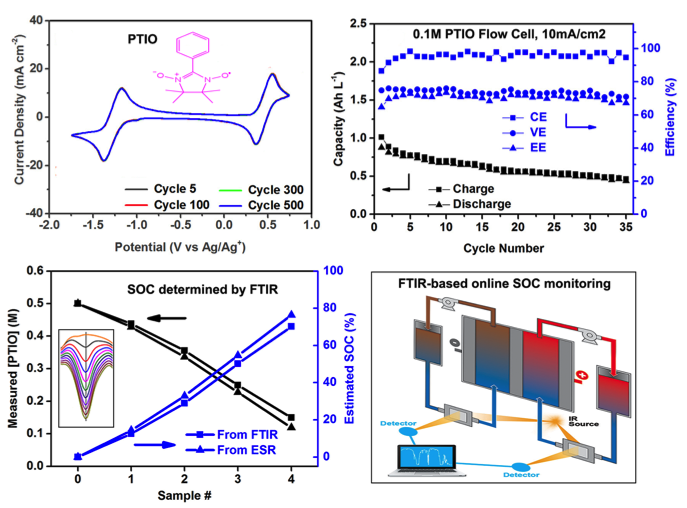
(2) FTIR-based state of charge monitoring
Scientific Achievement
A symmetric nonaqueous flow battery based on the highly soluble, ambipolar PTIO achieved a cell voltage of ~1.7V and decent cyclability. We demonstrated FTIR as an effective method to monitor the state of charge (SOC) of this flow battery.
Significance and Impact
The symmetrical flow battery design has the potential to reduce irreversible crossover and increase the effective redox material concentration. As a cheap, fast, and reliable diagnostic technique, FTIR can be applied for online SOC monitoring of the flow batteries using FTIR-active organic redox materials.
Research Details
- The electrochemical properties of PTIO were determined under cyclic voltammetry and flow cell testing conditions. Decent cyclability was achieved.
- FTIR satisfied the requirements for SOC determination because of its ability to distinguish among PTIO’s three oxidation states, have negligible interference from supporting electrolyte, and show [PTIO] dependence.
- FTIR were measured for the samples taken out a charging PTIO flow cell at specified time intervals to determine [PTIO] and SOC. Electron spin resonance (ESR) results cross-validated the FTIR results.
Work performed at Pacific Northwest National Laboratory (JCESR partner), University of Illinois (JCESR partner), MIT (JCESR collaborator), UTRC (JCESR collaborator) and Argonne National Laboratory (JCESR managing partner) by W. Duan, R. S. Vemuri, J. D. Milshtein, S. Laramie, R. D. Dmello, J. Huang, L. Zhang, D. Hu, M. Vijayakumar, W. Wang, J. Liu, R. M. Darling, L. Thompson, K. Smith, J. S. Moore, F. R. Brushett, X. Wei, J. Materials Chem. A, 2016.
DOI: 10.1039/C6TA01177B.

